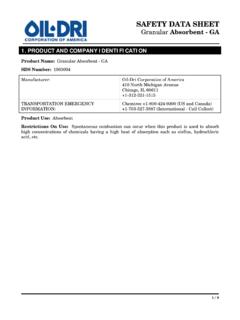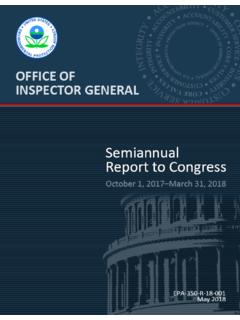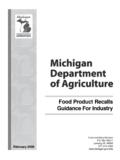Transcription of Granular Absorbent (#1003000)
1 Material Safety Data Sheet Granular Absorbent (#1003000). 410 North michigan Avenue Chicago, IL 60611 ( (312)321-1515, Information (800)424-9300, Emergency 1. PRODUCT IDENTIFICATION. MSDS Number: 1003000. Identity: Granular Absorbent Issued: July 5, 2011. Chemical Name Fullers Earth and/or bentonite or amorphous opaline silica 2. COMPOSITION. Component CAS Number Amount Silica Hydrated (Amorphous Opaline Silica) 7631-86-9 90-100%. Fullers Earth 8031-18-3 90-100%. Bentonite 1302-78-9 90-100%. Quartz (respirable <1%) 14808-60-7 <10% bulk 3. HAZARDS IDENTIFICATION. EMERGENCY OVERVIEW. This product is a non-combustible, chemically inert mineral.)
2 This mineral sample contains naturally-occurring crystalline silica as quartz. Prolonged overexposure to respirable crystalline silica may cause lung disease (silicosis). IARC, in Monograph 68, has concluded that crystalline silica inhaled in the form of quartz from occupational sources is carcinogenic to humans (Group 1); however, carcinogenicity was not detected in all industrial circumstances studied. The company is not aware of any scientific or medical data available indicating that exposure to dust from this product under conditions of normal use will cause silicosis or cancer. Adverse effects would not be expected from normal use of this product.
3 HEALTH HAZARDS. INGESTION: No adverse effects expected with unused material. INHALATION: Inhalation of excessive concentrations of dust may cause irritation of mucous membranes and upper respiratory tract. EYE: Contact may cause mechanical irritation and possible injury. SKIN: No adverse effects expected. SENSITIZATION: No adverse effects expected. CHRONIC/CARCINOGENICITY: Inhalation of excessive concentrations of any dust, including this material, may lead to lung injury. This product contains crystalline silica. Excessive inhalation of respirable crystalline silica may cause silicosis, a progressive, disabling and fatal disease of the lung.
4 Symptoms may include cough, shortness of breath, wheezing and reduced pulmonary function. The International Agency for Research on Cancer (IARC), in Monograph 68 has concluded that crystalline silica inhaled in the form of quartz or cristobalite, from occupational sources is carcinogenic to humans (Group 1). However, in making the overall evaluation, the Working Group noted that carcinogenicity was not detected in all industrial circumstances studied. Carcinogenicity may be dependent on inherent characteristics of the crystalline silica or on external factors affecting its Issued on July 5, 2011 Page 1 of 6. Material Safety Data Sheet Granular Absorbent (#1003000).
5 410 North michigan Avenue Chicago, IL 60611 ( (312)321-1515, Information (800)424-9300, Emergency biological activity or distribution of its polymorphs. The National Toxicology Program (NTP) classifies crystalline silica as a known carcinogen. The company is not aware of any scientific or medical data available indicating that exposure to dust from this product under conditions of normal use will cause silicosis or cancer. Adverse effects would not be expected from normal use of this product. MEDICAL CONDITIONS AGGRAVATED BY EXPOSURE: None currently known. 4. FIRST AID MEASURES. EYE: Immediately flush eyes with cool running water, lifting upper and lower lids.)
6 If irritation persists or for foreign body in the eye, get immediate medical attention. SKIN: None needed for normal use. INGESTION: If used material is ingested, get medical attention due to possibility of chemical contamination. If large amount of unused material is swallowed, get immediate medical attention. INHALATION: Remove to fresh air. 5. FIREFIGHTING MEASURES. FLASH POINT: This product is not combustible. FLAMMABLE LIMITS Not applicable EXTINGUISHING MEDIA: Use media that is appropriate for surrounding fire. UNUSUAL FIRE OR EXPLOSION HAZARDS: None SPECIAL FIREFIGHTING INSTRUCTIONS. None required. HAZARDOUS COMBUSTION PRODUCTS: None Issued on July 5, 2011 Page 2 of 6.
7 Material Safety Data Sheet Granular Absorbent (#1003000). 410 North michigan Avenue Chicago, IL 60611 ( (312)321-1515, Information (800)424-9300, Emergency 6. ACCIDENTAL release MEASURES. Sweep up and collect for re-use or disposal 7. HANDLING AND STORAGE. HANDLING: Avoid breathing dust. If clothing becomes dusty, launder before re-use. STORAGE: Store in a dry area. 8. EXPOSURE CONTROLS/PERSONAL PROTECTION. EXPOSURE GUIDELINES: Component Exposure Limit Silica Hydrated (Amorphous Opaline Silica) PEL - 80 mg/m / % SiO2. Fullers Earth PEL - 15 mg/m TWA (total dust). PEL - 5 mg/m TWA (respirable fraction). Bentonite PEL - 15 mg/m TWA (total dust).)
8 PEL - 5 mg/m TWA (respirable fraction). Quartz (respirable <1%) PEL - 10 mg/m /%Si02+2 TWA. TLV - mg/m TWA. PEL- OSHA Permissable Exposure Limit. TLV- American Conference of Governmental Industrial Hygienists (ACGIH) Threshold Limit Value. TWA- 8 hour Weighted Average. STEL-Short Term Exposure Limit. ENGINEERING CONTROLS: For operations where the exposure limit may be exceeded, local exhaust ventilation is recommended. RESPIRATORY PROTECTION: For operations where the exposure limit may be exceeded, a NIOSH/MSHA approved high efficiency particulate respirator is recommended. SKIN PROTECTION: None required for normal use. EYE PROTECTION: Safety glasses or goggles recommended.
9 OTHER: None required for normal use. 9. PHYSICAL AND CHEMICAL PROPERTIES. APPEARANCE AND ODOR: Gray to tan (or red) granules, no odor PHYSICAL STATE: Solid BOILING POINT: Not applicable VAPOR PRESSURE: Not applicable VAPOR DENSITY: Not applicable SOLUBILITY IN WATER: Insoluble SPECIFIC GRAVITY: Issued on July 5, 2011 Page 3 of 6. Material Safety Data Sheet Granular Absorbent (#1003000). 410 North michigan Avenue Chicago, IL 60611 ( (312)321-1515, Information (800)424-9300, Emergency SPECIFIC GRAVITY: pH: Not applicable MELTING POINT: Not applicable OCTANOL/WATER COEFFICIENT: Not available 10. STABILITY AND REACTIVITY. STABILITY: Stable INCOMPATIBILITY: Physical contact between this material and turpentine, hydrofluoric acid, vegetable oil or other unsaturated organic compounds (such as fish oil) may generate heat and/or fire.)
10 Do not use this material with these compounds. HAZARDOUS DECOMPOSITION PRODUCTS: None HAZARDOUS POLYMERIZATION: Will not occur. 11. TOXICOLOGICAL INFORMATION. No data available. 12. ECOLOGICAL INFORMATION. No data available. 13. DISPOSAL CONSIDERATIONS. Dispose in accordance with local, state and federal environmental regulations. Unused material is suitable for disposal in sanitary landfill. Used material may be subject to regulation, depending on the nature of the material absorbed. Check with appropriate regulatory authority for used material containing hazardous waste. 14. TRANSPORT INFORMATION. PROPER SHIPPING NAME: Not regulated UN NUMBER: Not applicable HAZARD CLASS/PACKING GROUP: Not applicable LABELS REQUIRED: None Issued on July 5, 2011 Page 4 of 6.








